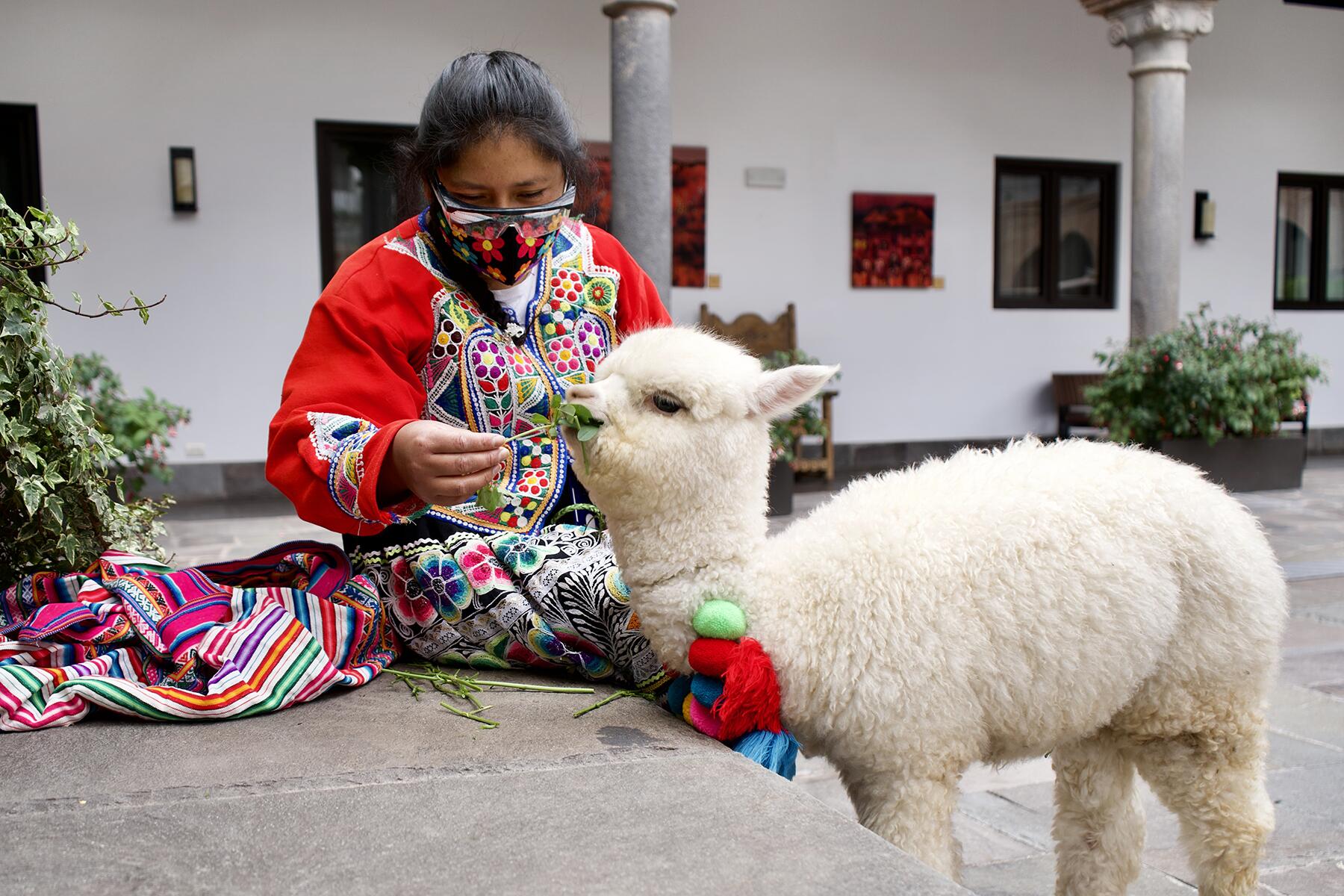Their adorable animals and brightly colored clothing make them a tourist staple, but the alpaca ladies face a number of challenges.
You can’t miss their brightly embroidered skirts and jackets. You certainly can’t miss their adorable lambs and baby alpacas. On any given day, there are a couple of dozen women in Cusco who come dressed in traditional outfits, ready to pose for photos with their freshly shampooed animals. Every day hundreds of photos of them are uploaded to social media all around the world.
“This isn’t a costume. This is what my mother wears. This is what my grandmother wore,” says Bonifacia. Originally from Quispicanchis, Bonifacia and her younger sister Elodia have been posing for photos with tourists in Cusco for the past six years. Bonifacia has worked to support her family since she was sixteen when her father passed away. Her mother was left with eight children, the youngest only six months old. As a teenager, Bonifacia would buy products in town and hike up into the mountains to sell them in small villages. Her first language is Quechua, and she also speaks Spanish. Elodia speaks only a few words of Spanish. Neither of them can read or write. There aren’t a lot of jobs available for women like them in Cusco, especially not jobs that offer them the opportunity to earn as much as they can modeling for photos.
Recommended Fodor’s Video
“Panchito is three months old,” Bonifacia says, introducing her alpaca to me. “I bring alfalfa and bottles of milk for him every day.”
Bonifacia says that sometimes people worry that the alpacas they see in the city aren’t well cared for, but she says they’re like any pet. They’re well-fed, bathed, and taken to the vet when necessary. They also have names, like Blanca, the alpaca that accompanies Leonarda, who is from the village of Hatun Q’ero.
“Blanca knows her name and will come when I call. Alpacas are smart and you can train them like dogs,” says Leonarda, who has been coming to Cusco to pose for photos for twenty years. As if to prove her point, Blanca stood up, stretched, and walked a few yards away to urinate in the gutter. She looked around lazily, then came back when Leonarda called her name. Leonarda and Blanca work most days in front of the Santo Domingo Church, which is also the popular tourist destination Qorikancha, the Incan Temple of the Sun.

“I think it’s so important that they can represent their culture,” says Claudia Valdez from Mexico City. She and her family are spending only a few days in Cusco but one of their favorite sights in the city is what she calls the “alpaca ladies.”
“I like how people here in Cusco still speak Quechua,” she continued. “In Mexico, many people used to speak Nahuatl or other indigenous languages, but these things are being lost.” Valdez has taken photos of her daughter with several women and their alpacas. She appreciates seeing the indigenous culture that the alpaca ladies bring to a tourist’s experience of the city.
“I wish that they had more support, that there was a place for them to work in Cusco,” Valdez adds. Currently, the women who model for photos have to keep moving through the city, since staying in one place is considered the same as setting up shop in a public area and therefore forbidden by city ordinance.
“Their colorful dress is a nice reflection of Cusco culture,” remarks Mike Vose. Originally from New Zealand, Mike has spent most of 2021 living in Cusco. “I wish there was a way for them to communicate more easily with visitors, explaining where they are from and the meaning of their dresses.” While some of the women speak a few words of English, most speak only Spanish and Quechua. Not all of them speak Spanish and some must rely on their companions to translate their Quechua when necessary.

“Tourists like to take photos with us, but what they really come for are the animals,” says Victoria. “If I don’t at least have a lamb with me, tourists can’t tell if I’m here for them to take photos.” Like about half of the alpaca ladies, Victoria comes from a community called Fortaleza Sacsayhuaman. The village is just uphill from the Inca fortress of Sacsayhuaman, which is one of the most popular tourist destinations in Cusco.
The women from Fortaleza Sacsayhuaman wear a wide variety of bowler hats and knit their own colorful cardigans and sweaters. This sets them apart from the women who come from Quispicanchis or the region of Paucartambo. Bonifacia and Elodia wear brightly embroidered skirts and jackets, like all women from Quispicanchis. They also wear flat hats called “montera,” which come in many different colors and are also embroidered. Bonifacia brings an extra montera with her for any tourists who want to wear one in their photos. She says that what she enjoys most about this work is meeting people from all over the world.

“My favorite thing about this job is when tourists ask me to sing,” says Lisbeth, who is from Paucartambo. “Peruvian tourists sometimes ask me to sing a traditional song in Quechua.” Many women shared with me that what they like most about modeling for photos is the flexibility and the opportunity to earn more than they would at other jobs. During the lockdown of 2020, most were stuck at home in their villages, planting potatoes and caring for their alpaca. It was a harsh reminder of how difficult farming is and how little a person can earn at it.
But all the women I spoke with agreed that the hardest part of their job is dealing with the city security guards. There is a private security force hired by the city of Cusco to provide extra security in the most touristy areas of town. They treat the alpaca ladies the same as anybody selling in the streets.
“Street vendors are prohibited in Cusco by city ordinance,” says Juan Carlos Galdos Tejada, Director of Economic Development and Municipal Services for the city of Cusco. Part of the security guards’ job is to ask vendors to move along when they have settled in one place. “Farm animals are also prohibited in the center of the city,” adds Galdos.
Herein lies the rub for the alpaca ladies. Youana Huaracca Amao, of the association Las Ñustas Sonq’oykipi Ttcarisunchis, says that in meetings with the mayor, the women have been offered permission to have animals with them in less central areas of the city. However, if they want to earn a livable daily income, they need to be in the center of the city, near the plazas and archeological sites that are most popular with tourists.
Another issue in contention is that before the pandemic, lambs and alpacas were routinely confiscated by the city security guards. More than ten women I spoke with allege that their animals were never returned nor were they compensated for the loss of property. The women allege that they were taken to a petting zoo named Cusco Park. Also, all of them say that more than the monetary value of the animals, the women were most distressed by how their pets were treated after they were confiscated.
“I always feed my alpacas milk and alfalfa, but I heard that they are only given hay at the petting zoo,” bemoans Maria, who is from Fortaleza Sacsayhuaman. “I’m so worried about what happened to the alpaca they took from me before the pandemic.” Cusco Park is now closed and has been since Peru went into lockdown on March 15, 2020.
“Nobody knows about Cusco Park,” says Robbie Dixon, who is from the U.S. and visited the park in 2019. “They had all kinds of animals: vicuña, alpaca, llamas, lambs, chickens, and pigs. Now some of them were in small cages and that really made me mad. Some of them were in an open field but it wasn’t very big.”
Bonifacia’s daughter Kely also visited Cusco Park in 2019. She went to look for her aunt Elodia’s lamb after it was confiscated. “I took milk for her, but they wouldn’t let me give it to her. My mom sent me to try to get the lamb back because she was so young. She needed milk.” Kely paid the entrance fee and pretended to be a tourist, but she couldn’t find her aunt’s lamb.
Many of the women told me that they have tried to petition the city for their work to be recognized as legitimate. They don’t want to be treated like illegal street vendors. “We need a permit system so that our animals are registered and can’t be confiscated,” explains Victoria. “They’re not livestock. They’re pets.”

On the best days, especially during July and August, a woman posing for photos can earn up to s/80 Peruvian Soles, which is about $20 US Dollars. Most days, they earn between s/20 and s/40. On rainy days, they can earn as little as s/10. This doesn’t even cover transportation, let alone food for themselves and their pets. The women in Fortaleza Sacsayhuaman can walk down to the historic center of Cusco for work but other women live farther south of the city, where they can afford to have land for their alpaca and sheep. Busses into the city don’t allow animals, so the women are forced to pay for taxis to get to and from work.
“We don’t charge a set fee and only ask tourists to give a voluntary tip. Sometimes they pay s/1 or s/5. If we were recognized as legitimate workers, we could have a set price and that would be easier for tourists,” explains Kely. She is 25 years old and is saving the money she earns to start her own business. “I like working for myself,” she says with a smile.




